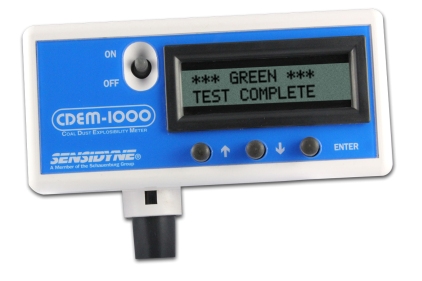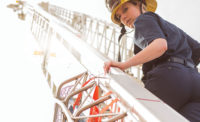 Researchers at the National Institute for Occupational Safety and Health (NIOSH) have developed a real-time dust explosibility measuring instrument to provide instant feedback to miners on the potential for dust accumulations and the effectiveness of their rock dusting practices.
Researchers at the National Institute for Occupational Safety and Health (NIOSH) have developed a real-time dust explosibility measuring instrument to provide instant feedback to miners on the potential for dust accumulations and the effectiveness of their rock dusting practices.
The Coal Dust Explosibility Meter (CDEM) is a simple-to-use handheld device that provides a pass/fail assessment of coal mine dust samples. NIOSH says the device will give miners, mine operators and regulators the information they need to take immediate action to eliminate an explosion hazard.
Accumulations of combustible dust in coal mines creates the risk of large-scale explosions that can result in fatalities and injuries among miners working underground. From 1986 to 2010, there were seven multiple-fatality explosions in underground coal mines. Inadequate rock dusting or poor rock dusting practices was a contributing factor in these explosions.
Determining when rock dust should be applied (a practice which helps control the explosion hazard) previously relied on a visual evaluation or the collection and analysis of dust samples – a process which can require days or even weeks.
In order to reduce the risk of underground mine explosions, combustible gas and dust accumulations must be constantly monitored. Sources of ignition must be limited as well.
“For decades, miners have been able to monitor the concentrations of methane and other combustible gasses using handheld, direct reading gas detectors,” according to NIOSH. “These detectors have allowed miners to take immediate action to dilute gasses and prevent explosions.” NIOSH researchers kept this purpose in mind when developing the CDEM.
The device received MSHA IS (intrinsically safe) approval in 2011 and is now commercially available.
The CDEM owes its existence to NIOSH's mine safety and health research program and its predecessor program in the U.S. Bureau of Mines—in collaboration with the Mine Safety and Health Administration (MSHA). Researchers first focused on identifying a technology that could provide real-time results comparable to the existing laboratory test, and then transferred the technology from a laboratory setting to a rugged hand held device— which received the R&D 100 Award in 2006 for Innovation in Technology. The device was further refined in order to pass the rigorous MSHA evaluation for intrinsic electrical safety.
In late 2010, NIOSH upgraded the device software to include ambient methane in the hazard determination and revised the calibration procedures to address issues identified in an earlier MSHA field study. In April of 2011, MSHA approved the CDEM for use in underground coal mines.
“Attempts to commercialize the instrument over the past 10 years were unsuccessful due to a lack of market interest,” notes NIOSH. “However, recent events have renewed interest from key stakeholders in bringing the CDEM to market.”
The CDEM was ultimately commercialized as a joint effort between NIOSH and Sensidyne and is available for purchase.
A NIOSH statement observes; “Before the CDEM, mines were not aware they were in violation for weeks after the hazard was discovered. The CDEM will now allow these excessive accumulations to be immediately evaluated and abated, resulting in safer work environments for miners.”





